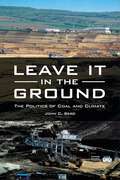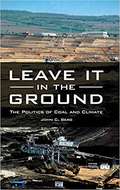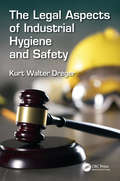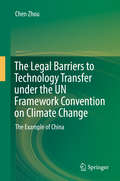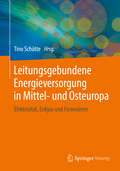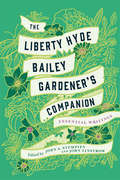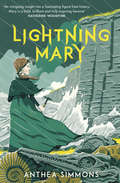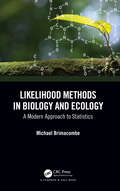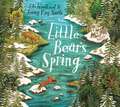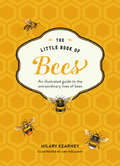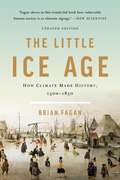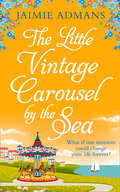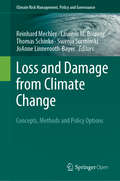- Table View
- List View
Leave It in the Ground: The Politics of Coal and Climate
by John C. BergEmploying scientific explanations and hard data, this book shows why coal is such a problem, how the pro-coal forces got to be so powerful, and how those forces might be defeated through political activism.Coal provided the energy to build modern civilization. This energy source raised standards of living, multiplied the earth's population, and enabled people in developed countries to enjoy leisure time. Today, we know that if we burn all the coal available, climate change will continue to increase. But the use of coal isn't purely an environmental issue; there are also political and economic forces at play. This book examines the politics and environmental impact of coal production and distribution, presenting a clear point of view—that we must shift away from coal use—backed by hard data and supplying specific prescriptions for opposing and regulating the coal industry.Author John C. Berg explains how ending the burning of coal (and of oil and natural gas) is a political problem rather than a technical one; explodes the "clean coal" myth, providing scientific documentation of how burning coal emits more greenhouse gases per unit of energy than any other fuel; and describes how controlling coal use in the United States will also serve to restore the possibility of a meaningful international climate agreement. Additionally, readers will understand the critical importance of activism—from local to international—in spurring government regulation to control the coal industry, which can only be defeated politically.
Leave It in the Ground: The Politics of Coal and Climate
by John C. BergEmploying scientific explanations and hard data, this book shows why coal is such a problem, how the pro-coal forces got to be so powerful, and how those forces might be defeated through political activism.Coal provided the energy to build modern civilization. This energy source raised standards of living, multiplied the earth's population, and enabled people in developed countries to enjoy leisure time. Today, we know that if we burn all the coal available, climate change will continue to increase. But the use of coal isn't purely an environmental issue; there are also political and economic forces at play. This book examines the politics and environmental impact of coal production and distribution, presenting a clear point of view—that we must shift away from coal use—backed by hard data and supplying specific prescriptions for opposing and regulating the coal industry.Author John C. Berg explains how ending the burning of coal (and of oil and natural gas) is a political problem rather than a technical one; explodes the "clean coal" myth, providing scientific documentation of how burning coal emits more greenhouse gases per unit of energy than any other fuel; and describes how controlling coal use in the United States will also serve to restore the possibility of a meaningful international climate agreement. Additionally, readers will understand the critical importance of activism—from local to international—in spurring government regulation to control the coal industry, which can only be defeated politically.
The Legal Aspects of Industrial Hygiene and Safety (Sustainable Improvements in Environment Safety and Health)
by Kurt W. DregerThe Legal Aspects of Industrial Hygiene and Safety explores various legal issues that are often encountered by Industrial Hygiene and Safety managers during their careers. A description is presented of the various legal concepts and processes that often arise in the IH/S practice, including tort, contract, and administrative law. The goal is to provide IH/S managers with sufficient knowledge to be able to incorporate legal risk analysis into everyday decision-making and policy development. This book will explore the legal issues that arise in IH/S practice and will be helpful to new IH/S managers as they progress in their careers. FEATURES Explores various legal issues that are often encountered by Industrial Hygiene and Safety managers during their careers Provides insight into the legal issues and processes to IH/S managers that are traditionally only available to attorneys Improves the IH/S managers' ability to communicate complex IH/S issues to in-house counsel Presents tools and knowledge to IH/S managers so they can better consider the legal risks of the decisions they make Covers various legal concepts and processes that can arise in the IH/S practice, including tort, contract, and administrative law
The Legal Aspects of Industrial Hygiene and Safety (Sustainable Improvements in Environment Safety and Health)
by Kurt W. DregerThe Legal Aspects of Industrial Hygiene and Safety explores various legal issues that are often encountered by Industrial Hygiene and Safety managers during their careers. A description is presented of the various legal concepts and processes that often arise in the IH/S practice, including tort, contract, and administrative law. The goal is to provide IH/S managers with sufficient knowledge to be able to incorporate legal risk analysis into everyday decision-making and policy development. This book will explore the legal issues that arise in IH/S practice and will be helpful to new IH/S managers as they progress in their careers. FEATURES Explores various legal issues that are often encountered by Industrial Hygiene and Safety managers during their careers Provides insight into the legal issues and processes to IH/S managers that are traditionally only available to attorneys Improves the IH/S managers' ability to communicate complex IH/S issues to in-house counsel Presents tools and knowledge to IH/S managers so they can better consider the legal risks of the decisions they make Covers various legal concepts and processes that can arise in the IH/S practice, including tort, contract, and administrative law
The Legal Barriers to Technology Transfer under the UN Framework Convention on Climate Change: The Example of China
by Chen ZhouThe book discusses climate technology transfer under the UNFCCC framework, and China’s relevant legislation and practices. It first explores theoretical basis of climate change-related technology transfer, with a particular focus on the differences between climate technology transfer and business-as-usual performance. The book then reviews practices of both technology supplier and user, in order to generally identify potential legal barriers and obstacles. Finally, it sheds light on China, providing a comprehensive assessment on barriers that hinder the trans-boundary transfers of low carbon technologies and need to be overcome in future. The issues concerned involve two of the most dynamic areas in current China’s lawmaking progress: environment laws and Intellectual Property laws. The book provides an in-depth analysis on China’s legislation and practices in this regard. At international level, the legal framework of climate technology transfer is examined in a systematic, prudent and constructive manner. On this basis, the book highlights potential commons, consistency and possible coordination between the UNFCCC and the WTO regime. This book is accessible to both Chinese and international environmental law specialists. It appeals to a broad readership, including environmental scientists, economists concerned with China’s intellectual property law, foreign investment law and anyone interested in the topic: how to green intellectual property rights regime for climate technology transfer in the China context.
Legal Liabilities in Safety and Loss Prevention: A Practical Guide, Third Edition (Occupational Safety & Health Guide Series)
by Thomas D. SchneidThe goal of every safety professional and safety program is to be proactive and to identify problems while complying within safety guidelines. This book clarifies basic questions about legal liability, how to minimize, prevent, and identify legal risks. Appendices, case studies, and sample forms are included in this resource. The whole book will be revised due to the laws and regulations in the workplace changing. This revised edition will address all of the changes in the laws as well as providing guidance on how to achieve and maintain compliance. Features Covers methods to achieve and maintain compliance Includes new standards and regulations Discusses defense, rights, and responsibilities Provides a guide to professionals who are unfamiliar with reviewing, analyzing, and briefing a court decision Offers a new chapter on environmental and labor
Legal Liabilities in Safety and Loss Prevention: A Practical Guide, Third Edition (Occupational Safety & Health Guide Series)
by Thomas D. SchneidThe goal of every safety professional and safety program is to be proactive and to identify problems while complying within safety guidelines. This book clarifies basic questions about legal liability, how to minimize, prevent, and identify legal risks. Appendices, case studies, and sample forms are included in this resource. The whole book will be revised due to the laws and regulations in the workplace changing. This revised edition will address all of the changes in the laws as well as providing guidance on how to achieve and maintain compliance. Features Covers methods to achieve and maintain compliance Includes new standards and regulations Discusses defense, rights, and responsibilities Provides a guide to professionals who are unfamiliar with reviewing, analyzing, and briefing a court decision Offers a new chapter on environmental and labor
Legal Rights for Rivers: Competition, Collaboration and Water Governance (Earthscan Studies in Water Resource Management)
by Erin O'DonnellIn 2017 four rivers in Aotearoa New Zealand, India, and Colombia were given the status of legal persons, and there was a recent attempt to extend these rights to the Colorado River in the USA. Understanding the implications of creating legal rights for rivers is an urgent challenge for both water resource management and environmental law. Giving rivers legal rights means the law can see rivers as legal persons, thus creating new legal rights which can then be enforced. When rivers are legally people, does that encourage collaboration and partnership between humans and rivers, or establish rivers as another competitor for scarce resources? To assess what it means to give rivers legal rights and legal personality, this book examines the form and function of environmental water managers (EWMs). These organisations have legal personality, and have been active in water resource management for over two decades. EWMs operate by acquiring water rights from irrigators in rivers where there is insufficient water to maintain ecological health. EWMs can compete with farmers for access to water, but they can also strengthen collaboration between traditionally divergent users of the aquatic environment, such as environmentalists, recreational fishers, hunters, farmers, and hydropower. This book explores how EWMs use the opportunities created by giving nature legal rights, such as the ability to participate in markets, enter contracts, hold property, and enforce those rights in court. However, examination of the EWMs unearths a crucial and unexpected paradox: giving legal rights to nature may increase its legal power, but in doing so it can weaken community support for protecting the environment in the first place. The book develops a new conceptual framework to identify the multiple constructions of the environment in law, and how these constructions can interact to generate these unexpected outcomes. It explores EWMs in the USA and Australia as examples, and assesses the implications of creating legal rights for rivers for water governance. Lessons from the EWMs, as well as early lessons from the new ‘river persons,’ show how to use the law to improve river protection and how to begin to mitigate the problems of the paradox.
Legal Rights for Rivers: Competition, Collaboration and Water Governance (Earthscan Studies in Water Resource Management)
by Erin O'DonnellIn 2017 four rivers in Aotearoa New Zealand, India, and Colombia were given the status of legal persons, and there was a recent attempt to extend these rights to the Colorado River in the USA. Understanding the implications of creating legal rights for rivers is an urgent challenge for both water resource management and environmental law. Giving rivers legal rights means the law can see rivers as legal persons, thus creating new legal rights which can then be enforced. When rivers are legally people, does that encourage collaboration and partnership between humans and rivers, or establish rivers as another competitor for scarce resources? To assess what it means to give rivers legal rights and legal personality, this book examines the form and function of environmental water managers (EWMs). These organisations have legal personality, and have been active in water resource management for over two decades. EWMs operate by acquiring water rights from irrigators in rivers where there is insufficient water to maintain ecological health. EWMs can compete with farmers for access to water, but they can also strengthen collaboration between traditionally divergent users of the aquatic environment, such as environmentalists, recreational fishers, hunters, farmers, and hydropower. This book explores how EWMs use the opportunities created by giving nature legal rights, such as the ability to participate in markets, enter contracts, hold property, and enforce those rights in court. However, examination of the EWMs unearths a crucial and unexpected paradox: giving legal rights to nature may increase its legal power, but in doing so it can weaken community support for protecting the environment in the first place. The book develops a new conceptual framework to identify the multiple constructions of the environment in law, and how these constructions can interact to generate these unexpected outcomes. It explores EWMs in the USA and Australia as examples, and assesses the implications of creating legal rights for rivers for water governance. Lessons from the EWMs, as well as early lessons from the new ‘river persons,’ show how to use the law to improve river protection and how to begin to mitigate the problems of the paradox.
Leitungsgebundene Energieversorgung in Mittel- und Osteuropa: Elektrizität, Erdgas und Fernwärme
by Tino Schütte Emil Dvorský Olga Borozdina Arvydas Galinis Géza Mészáros Vaclovas Miškinis Edyta Ropuszyńska-Surma Gunta Šlihta Kaspars Šlihta Andrea Simon Kvetoslava Šoltésová Jaroslav Šoltés Zdzisław Szalbierz Magdalena Węglarz Lenka Raková Martin SirovýEine funktionierende leitungsgebundene Energieversorgung ist Voraussetzung für die industrielle Entwicklung eines Landes. Das Buch gibt einen fundierten Überblick über die Strom-, Gas- und Fernwärmeversorgungssysteme in den Ländern der Visegrad-Gruppe, des Baltikums sowie Russlands, Belarus und der Ukraine. Gleichzeitig werden Ansatzpunkte zur Modernisierung der Energienetze offengelegt. Nationale Besonderheiten und Entwicklungsstände werden aufgezeigt. Durch die abgestimmte Struktur der Beiträge ist ein Vergleich der Systeme möglich. Die Länderberichte sind von ausgewiesenen Fachleuten der betreffenden Staaten verfasst. Sie spiegeln die seit 25 Jahren bestehende Zusammenarbeit im Rahmen des Zittauer Energieseminars zur energiewirtschaftlichen Situation in Mittel- und Osteuropa wider. Jeder Beitrag beinhaltet eine technisch-ökonomische Sachstandsanalyse und geht auf Entwicklungsperspektiven ein. Das Werk zeigt Verbesserungspotentiale bzgl. Infrastrukturausbau und Energieeffizienz auf.
The Liberty Hyde Bailey Gardener's Companion: Essential Writings
by Liberty Hyde Bailey"Every family can have a garden." -Liberty Hyde BaileyFinally, the best and most accessible garden writings of perhaps the most influential literary gardener of the twentieth century have been brought together in one book. Philosopher, poet, naturist, educator, agrarian, scientist, and garden-lover par excellence Liberty Hyde Bailey built a reputation as the Father of Modern Horticulture and evangelist for what he called the "garden-sentiment"—the desire to raise plants from the good earth for the sheer joy of it and for the love of the plants themselves. Bailey's perennial call to all of us to get outside and get our hands dirty, old or young, green thumb or no, is just as fresh and stirring today as then.Full of timeless wit and grace, The Liberty Hyde Bailey Gardener's Companion collects essays and poems from Bailey's many books on gardening, as well as from newspapers and magazines from the era. Whether you've been gardening for decades or are searching for your first inspiration, Bailey's words will make an ideal companion on your journey.
Life at Walnut Tree Farm
by Rufus Deakin Titus RowlandsonIn 1970 Roger Deakin acquired Walnut Tree Farm, a semi-ruined Elizabethan farmhouse deep in the countryside of northern Suffolk, on the edge of Mellis Green, the largest area of common grazing land in England. The house's thatch and roof beams were rotting; pigs and hens had been its last occupants and the floors were ankle deep in shit. Leaving swinging London behind, Deakin bought the farm in a spirit of 'back to the land' fervour; and, in the coming decades, lovingly restored it. Deakin lived here until his death in 2006, dredging the moat (in which he swam daily), planting woods and buying more of the surrounding fields, where he grew hay and wild flowers. Walnut Tree Farm became a place of pilgrimage and inspiration for nature-lovers, writers, intellectuals and artists, while Deakin's Waterlog has become a much-loved classic of nature writing and gave impetus to the wild swimming movement. Rufus Deakin and Titus Rowlandson offer a beautifully illustrated and designed record of the development of Deakin's rural paradise, centred on a series of photographs taken by Roger Deakin himself, which record both the rebuilding of Walnut Tree Farm, the unique character of a remarkable building, and the seasonal cycle of nature in the land and countryside that surround it.
Lightning Mary
by Anthea SimmonsOrdinary is what most people are and I am not. I am not ordinary at all. I am a scientist.One stormy night, a group of villagers are struck by lightning. The only survivor is a baby - Mary Anning. From that moment on, a spark is lit within her.Growing up poor but proud on the windswept Dorset coast, Mary follows after her father, hunting for fossils uncovered by waves and landslips: ancient creatures, turned to stone. Ignoring other people's taunts, Mary faces danger to bring back valuable treasures to help feed her family. But tragedy and despair is never far away. Mary must depend upon her unique courage and knowledge to fulfil her dream of becoming a scientist in a time when girls have no opportunities for such ambitions. What will happen when she makes her greatest discovery of all...?With a factual section about Mary Anning, her life, and the discoveries she made.
Likelihood Methods in Biology and Ecology: A Modern Approach to Statistics
by Michael BrimacombeThis book emphasizes the importance of the likelihood function in statistical theory and applications and discusses it in the context of biology and ecology. Bayesian and frequentist methods both use the likelihood function and provide differing but related insights. This is examined here both through review of basic methodology and also the integr
Limits: Why Malthus Was Wrong and Why Environmentalists Should Care
by Giorgos KallisWestern culture is infatuated with the dream of going beyond, even as it is increasingly haunted by the specter of apocalypse: drought, famine, nuclear winter. How did we come to think of the planet and its limits as we do? This book reclaims, redefines, and makes an impassioned plea for limits—a notion central to environmentalism—clearing them from their association with Malthusianism and the ideology and politics that go along with it. Giorgos Kallis rereads reverend-economist Thomas Robert Malthus and his legacy, separating limits and scarcity, two notions that have long been conflated in both environmental and economic thought. Limits are not something out there, a property of nature to be deciphered by scientists, but a choice that confronts us, one that, paradoxically, is part and parcel of the pursuit of freedom. Taking us from ancient Greece to Malthus, from hunter-gatherers to the Romantics, from anarchist feminists to 1970s radical environmentalists, Limits shows us how an institutionalized culture of sharing can make possible the collective self-limitation we so urgently need.
Little Bear's Spring
by Elli WoollardLittle Bear's Spring is a breathtakingly beautiful story about a little bear, an unlikely friendship and how the coming of springtime can change everything.Little Bear has just woken up from his long winter sleep. But when he pokes his head out of the den, the world around him is vast, white and silent. The only thing he sees is a smooth little stone, just as alone in the snowy wilderness as he is. He nestles it in tight to his fur and off they go in search of friends. Little Bear's Spring is a lyrical story about friendship, with a gentle introduction to spring and what happens to the natural world when the seasons change. Written by star picture book author Elli Woollard and illustrated by Briony May Smith, whose artwork brings a sun-dappled springtime landscape to life with breathtaking beauty.
The Little Book of Bees: An Illustrated Guide To The Extraordinary Lives Of Bees
by Hilary KearneyBees continue to fascinate and charm us all – from novice gardeners and nature-lovers to dedicated environmentalists – and today, bees need our help more than ever. Discover the story of these incredible creatures, with The Little Book of Bees.
Little Gems – Nellie Choc-Ice and the Plastic Island (Little Gems)
by Jeremy StrongNellie Choc-Ice (the greatest penguin explorer in the world!) and Jeremy Strong return to fight the scourge of plastic in this funny and thoughtful gem.
The Little Ice Age: How Climate Made History 1300-1850
by Brian FaganOnly in the last decade have climatologists developed an accurate picture of yearly climate conditions in historical times. This development confirmed a long-standing suspicion: that the world endured a 500-year cold snap-The Little Ice Age-that lasted roughly from A.D. 1300 until 1850. The Little Ice Age tells the story of the turbulent, unpredictable and often very cold years of modern European history, how climate altered historical events, and what they mean in the context of today's global warming. With its basis in cutting-edge science, The Little Ice Age offers a new perspective on familiar events. Renowned archaeologist Brian Fagan shows how the increasing cold affected Norse exploration; how changing sea temperatures caused English and Basque fishermen to follow vast shoals of cod all the way to the New World; how a generations-long subsistence crisis in France contributed to social disintegration and ultimately revolution; and how English efforts to improve farm productivity in the face of a deteriorating climate helped pave the way for the Industrial Revolution and hence for global warming. This is a fascinating, original book for anyone interested in history, climate, or the new subject of how they interact.
The Little Vintage Carousel by the Sea
by Jaimie AdmansWhat if one moment could change your life forever? Ness has almost resigned herself to being single forever, when she catches sight of the most gorgeous man she’s ever seen on the train to work.
A Living Past: Environmental Histories of Modern Latin America (Environment in History: International Perspectives #13)
by John Soluri, Claudia Leal José Augusto PáduaThough still a relatively young field, the study of Latin American environmental history is blossoming, as the contributions to this definitive volume demonstrate. Bringing together thirteen leading experts on the region, A Living Past synthesizes a wide range of scholarship to offer new perspectives on environmental change in Latin America and the Spanish Caribbean since the nineteenth century. Each chapter provides insightful, up-to-date syntheses of current scholarship on critical countries and ecosystems (including Brazil, Mexico, the Caribbean, the tropical Andes, and tropical forests) and such cross-cutting themes as agriculture, conservation, mining, ranching, science, and urbanization. Together, these studies provide valuable historical contexts for making sense of contemporary environmental challenges facing the region.
Living with the Earth, Fourth Edition: Concepts in Environmental Health Science
by Gary S. Moore Kathleen A. BellShelving Guide; Environmental ScienceThis is a groundbreaking and innovative book now in its fourth edition. The first edition won the CHOICE award for outstanding Academic Book while editions two and three became bestsellers on their own right. This fourth edition is packed with new updates on current world events associated with environmental issues and related health concerns. The author maintains traditional concepts and merges them with new and controversial issues. The book has been revised to include up-to-date topics with and a revised Web site with updated links.So what Coverage of emergency preparedness for environmental health practitioners Discussion of population dynamics especially with regard to overpopulation and underpopulation around the world and their respective influences on social, economic, and environmental concerns. The mechanisms of environmental disease, emphasizing genetic disease and its role in developmental disorders and cancer. Human behaviors and pollution are presented along with respect to their roles in cancer risk. The ever increasing issues surrounding emerging and re-emerging diseases around the earth and the introduction of an increasing number of emerging diseases. The growing problems of asthma and other health effects associated with air pollution. An exploration of the mechanisms of toxicity with special reference to the immune system and endocrine disruption. The ongoing issues of the creation and disposal of hazardous waste along with the controversies surrounding disposal are presented. The issues and benefits of recycling are explored. The use of HACCP in assuring food quality, food safety issues, and the Food Quality Protection Act are discussed. Numerous technical illustrations, charts, graphs, and photographs are included What on the Web? Test bank and study questions giving a complete review of the concepts covered. Search tools for online journals and databases covering useful, up-to-date information in health and environmental topics Subject specific links by chapter as well as Federal, state, and organization sites with relevant information Downloadable PowerPoint files for each Chapter providing the instructor with ready-made presentation materials that can be modified as needed. Downloadable and printable test questions and answers for each chapter available to instructors
Living with the Earth, Fourth Edition: Concepts in Environmental Health Science
by Gary S. Moore Kathleen A. BellShelving Guide; Environmental ScienceThis is a groundbreaking and innovative book now in its fourth edition. The first edition won the CHOICE award for outstanding Academic Book while editions two and three became bestsellers on their own right. This fourth edition is packed with new updates on current world events associated with environmental issues and related health concerns. The author maintains traditional concepts and merges them with new and controversial issues. The book has been revised to include up-to-date topics with and a revised Web site with updated links.So what Coverage of emergency preparedness for environmental health practitioners Discussion of population dynamics especially with regard to overpopulation and underpopulation around the world and their respective influences on social, economic, and environmental concerns. The mechanisms of environmental disease, emphasizing genetic disease and its role in developmental disorders and cancer. Human behaviors and pollution are presented along with respect to their roles in cancer risk. The ever increasing issues surrounding emerging and re-emerging diseases around the earth and the introduction of an increasing number of emerging diseases. The growing problems of asthma and other health effects associated with air pollution. An exploration of the mechanisms of toxicity with special reference to the immune system and endocrine disruption. The ongoing issues of the creation and disposal of hazardous waste along with the controversies surrounding disposal are presented. The issues and benefits of recycling are explored. The use of HACCP in assuring food quality, food safety issues, and the Food Quality Protection Act are discussed. Numerous technical illustrations, charts, graphs, and photographs are included What on the Web? Test bank and study questions giving a complete review of the concepts covered. Search tools for online journals and databases covering useful, up-to-date information in health and environmental topics Subject specific links by chapter as well as Federal, state, and organization sites with relevant information Downloadable PowerPoint files for each Chapter providing the instructor with ready-made presentation materials that can be modified as needed. Downloadable and printable test questions and answers for each chapter available to instructors
Losing Earth: The Decade We Could Have Stopped Climate Change
by Nathaniel RichBy 1979, we knew all that we know now about the science of climate change – what was happening, why it was happening, and how to stop it. Over the next ten years, we had the very real opportunity to stop it. Obviously, we failed.Nathaniel Rich’s groundbreaking account of that failure – and how tantalizingly close we came to signing binding treaties that would have saved us all before the fossil fuels industry and politicians committed to anti-scientific denialism – is already a journalistic blockbuster, a full issue of the New York Times Magazine that has earned favorable comparisons to Rachel Carson’s Silent Spring and John Hersey’s Hiroshima. Rich has become an instant, in-demand expert and speaker. A major movie deal is already in place. It is the story, perhaps, that can shift the conversation.In the book Losing Earth, Rich is able to provide more of the context for what did – and didn’t – happen in the 1980s and, more important, is able to carry the story fully into the present day and wrestle with what those past failures mean for us in 2019. It is not just an agonizing revelation of historical missed opportunities, but a clear-eyed and eloquent assessment of how we got to now, and what we can and must do before it's truly too late.
Loss and Damage from Climate Change: Concepts, Methods and Policy Options (Climate Risk Management, Policy and Governance)
by Reinhard Mechler Laurens M. Bouwer Thomas Schinko Swenja Surminski JoAnne Linnerooth-BayerThis book provides an authoritative insight on the Loss and Damage discourse by highlighting state-of-the-art research and policy linked to this discourse and articulating its multiple concepts, principles and methods. Written by leading researchers and practitioners, it identifies practical and evidence-based policy options to inform the discourse and climate negotiations.With climate-related risks on the rise and impacts being felt around the globe has come the recognition that climate mitigation and adaptation may not be enough to manage the effects from anthropogenic climate change. This recognition led to the creation of the Warsaw International Mechanism on Loss and Damage in 2013, a climate policy mechanism dedicated to dealing with climate-related effects in highly vulnerable countries that face severe constraints and limits to adaptation. Endorsed in 2015 by the Paris Agreement and effectively considered a third pillar of international climate policy, debate and research on Loss and Damage continues to gain enormous traction. Yet, concepts, methods and tools as well as directions for policy and implementation have remained contested and vague.Suitable for researchers, policy-advisors, practitioners and the interested public, the book furthermore:• discusses the political, legal, economic and institutional dimensions of the issue• highlights normative questions central to the discourse• provides a focus on climate risks and climate risk management.• presents salient case studies from around the world.
